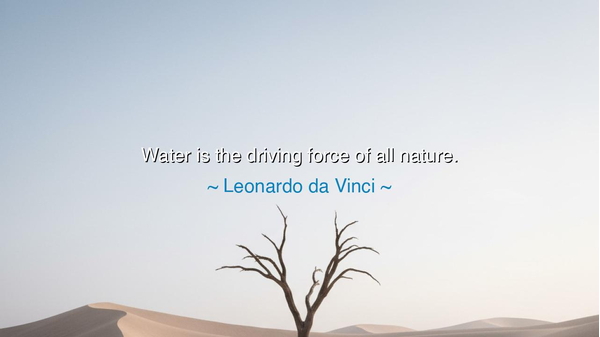
Water is the driving force of all nature.






Hearken, children of the ages, and attend to the words of Leonardo da Vinci, who, with the vision of a master and the soul of a seeker, proclaimed: "Water is the driving force of all nature." Herein lies a meditation upon the primacy of water as the sustainer of life, the shaper of landscapes, and the unseen power that animates every living being and every natural process. Da Vinci, ever a student of the world, observed that this humble element governs mountains and valleys, rivers and seas, and the rhythms of growth and decay.
In these words, water is not merely a substance, but a force, a vital energy that courses through the veins of the earth and the bodies of all creatures. It nourishes, shapes, and renews; it carves canyons, floods plains, and fills oceans. Leonardo understood that the visible beauty of nature—the dance of leaves, the flow of rivers, the bloom of fields—is sustained by this elemental current. To honor water is to honor the source of life itself.
Consider the historical example of ancient Egypt, where the Nile River determined the survival, culture, and prosperity of the civilization. Its annual floods deposited fertile silt, irrigated fields, and enabled the growth of crops that sustained millions. The Egyptians revered the Nile as divine, recognizing that water is indeed the driving force of nature, shaping societies, livelihoods, and the rhythms of life itself. Da Vinci’s observation echoes this eternal truth: without water, neither nature nor civilization can flourish.
Leonardo’s reflection also illuminates the interconnectedness of all things. Water moves from clouds to rivers, from oceans to rain, feeding plants, animals, and humans alike. It is a conduit of energy, a medium of transformation, and a mirror of the cycles of creation. Understanding the flow of water is to perceive the patterns of life, the unity of ecosystems, and the delicate balance upon which existence depends.
Consider the modern example of hydroelectric engineering. When rivers are harnessed with care, water can provide energy to millions, yet when mismanaged, it brings floods, droughts, and devastation. Humanity’s interaction with water exemplifies both the power of this driving force and the responsibility required to respect it. Leonardo’s insight teaches that knowledge of water is not merely scientific, but moral and practical—a call to stewardship of the forces that sustain life.
The lesson is profound: observe and honor the flows of water in your world. Recognize that it is the invisible architect of landscapes, the sustainer of life, and the measure of abundance or scarcity. Leonardo reminds us that mastery of nature comes not from domination, but from understanding the forces that animate it, and from aligning human activity with its rhythms.
Practical action follows naturally: conserve water, protect rivers, lakes, and wetlands, and respect the natural cycles of rain, tides, and aquifers. Study the flow of streams, the course of rivers, and the role of water in ecosystems. Let your awareness of water guide your choices in agriculture, urban planning, and daily life, honoring it as the driving force of all that lives and grows.
Thus, Leonardo da Vinci’s words endure as both revelation and counsel: water is the driving force of all nature, a force that shapes, sustains, and renews. Let all who hear remember that to respect and understand water is to engage with the very essence of life, to align with the eternal rhythms of the world, and to honor the source from which all creation flows.
If you wish, I can also craft a poetic, audio-ready version of this passage, where the cadence mirrors the flowing rivers and cascading waters, enhancing the emotional and heroic resonance of Leonardo’s insight. Do you want me to do that?






AAdministratorAdministrator
Welcome, honored guests. Please leave a comment, we will respond soon